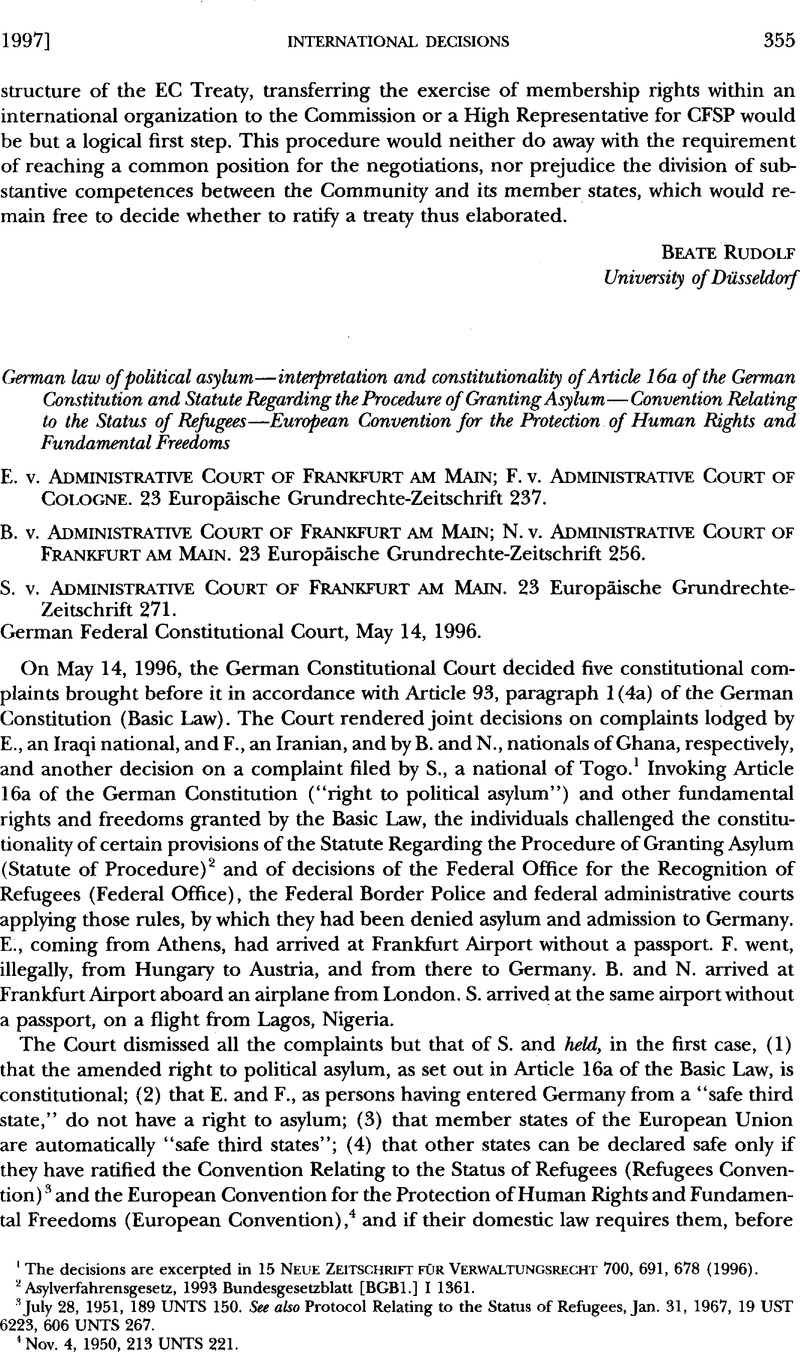Article contents
E. v. Administrative Court of Frankfurt am Main; F. v. Administrative Court of Cologne; B. v. Administrative Court of Frankfurt am Main; N. v. Administrative Court of Frankfurt am Main; S. v. Administrative Court of Frankfurt am Main
Published online by Cambridge University Press: 27 February 2017
Abstract

- Type
- International Decisions
- Information
- Copyright
- Copyright © American Society of International Law 1997
References
1 The decisions are excerpted in 15 Neue Zeitschrift für Verwaltungsrecht 700, 691, 678 (1996).
2 Asylverfahrensgesetz, 1993 Bundesgesetzblatt [BGBL] I 1361.
3 July 28, 1951, 189 UNTS 150. See also Protocol Relating to the Status of Refugees, Jan. 31, 1967, 19 UST 6223, 606 UNTS 267.
4 Nov. 4, 1950, 213 UNTS 221.
5 The article entered into force on June 30, 1993. See 1993 BGB1. I 1102, translated in 88 AJIL 363 (1994).
6 At present, in addition to the member states of the European Union, the following states are considered to be “safe third states”: the Czech Republic, Norway, Poland and Switzerland. See 1993 BGB1. I 1383.
7 At present, the following states are considered “safe countries of origin”: Bulgaria, the Czech Republic, Ghana, Hungary, Poland, Romania and Slovakia. See 1993 BGB1. I 1383, 1995 id. at 430, 1996 id. at 551.
8 Complaints of E. and F., sec. C I, para. 2 of the decision.
9 By determining that in a “safe third state” the application of the European Convention (with its Article 3 prohibition of torture or inhuman or degrading treatment or punishment) must be assured (Art. 16a, para. 2 of the Basic Law), and that no inhuman or degrading punishment or treatment may take place in a “safe country of origin” (Art. 16a, para. 3 of the Basic Law), the legislature also recognized Germany’s obligation under Article 3 of the UN Convention against Torture and Other Cruel, Inhuman or Degrading Treatment or Punishment, Dec. 10, 1984, 23 ILM 1027 (1984), 24 ILM 535 (1985), which requires state parties not to “expel, return (“refouler”) or extradite a person to another State where there are substantial grounds for believing that he would be in danger of being subjected to torture.” But see the reservation made by Germany on ratification of the Convention, in Multilateral Treaties Deposited with the Secretary -General : Status as at 31 D ecember 1994, UN Doc. ST/LEG/SER.E/13, at 178 (1995).
10 Complaints of E. and F., sec. C 12 b bb(2), para. 2 of the decision.
11 Complaints of B. and N., sec. C 12, para. 1 of the decision.
12 For a comprehensive analysis of the amendment, see Andreas Zimmermann , Das neue Grundrecht auf asyl (1994) (with a summary in English). See also Karin Oellers-Frahm & Andreas Zimmermann, France’s and Germany’s Constitutional Changes and Their Impact on Migration Law: Policy and Practice, 38 German Y.B. Int ’ l L. 249 (1995).
13 Today, 7.1 million (or 9%) of Germany’s total population of 81.6 million are foreign nationals, 26% more than in 1991. See Pressemitteilung des Statistischen Bundesamtes (Aug. 22, 1996).
14 In 1992, 438,191 persons applied for political asylum in Germany. The constitutional amendment having entered into force on June 30, 1993, the number decreased to 322,599 in 1993, and to 127,210 in 1994. In 1995, there were 127,937 applicants, the majority of whom came from the Federal Republic of Yugoslavia and Turkey (26,227 and 25,514, respectively). In 1995, the Federal Office decided on the applications of 200,188 persons, 18,100 (9%) of whom were granted asylum. See Bulletin des Presse - und Informationsamtes der Bundesregierung , Jan. 11, 1996, at 14–15.
15 For a review of the Court’s previous, generally liberal jurisprudence in asylum cases, see Rainer Hofmann, Recent jurisprudence of the German Federal Constitutional Court on asylum law, in The Living Law of Nations : Essays on refugees , minorities , indigenous peoples and the human rights of other vulnerable groups in memory of Atle Grahl -M adsen 97 (Gudmundur Alfredsson & Peter Macalister-Smith eds., 1996).
16 See Albrecht Randelzhofer, Asylrecht, in 6 Handbuch des Staatsrechts der Bundesrepublik Deutschland 185 (Josef Isensee & Paul Kirchhof eds., 1989). The interpretation of the former Article 16, paragraph 2 remains important for the question of who is “politically persecuted” under the Constitution.
17 See Christian Tomuschat, Asylrecht in der Schieflage, 23 Europaische Grundrechte -Zeitschrift 381, 386 (1996).
18 Agreement between the Governments of Belgium, Germany, France, Italy, Luxembourg, the Netherlands and Poland Concerning the Readmission of Persons Lacking Permission to Stay, Mar. 29, 1991, 1993 BGB1. II 1099; and Agreement between the Governments of Germany and the Czech Republic Concerning the Readmission of Persons at the German-Czech Border, Nov. 11, 1994, 1995 BGB1. II 134.
19 Agreement Implementing the Schengen Agreement of June 14, 1985, Between the Governments of the Countries of the Benelux Economic Union, Germany and France Regarding the Gradual Elimination of Passport and Customs Control at Their Common Borders, June 19, 1990, additionally signed by Italy Nov. 27, 1990, by Portugal and Spain June 25, 1991, and by Greece Nov. 6, 1992, Arts. 28–38, 1993 BGB1. II 1013, 1996 id. at 242. See also (Dublin) Convention Determining the State Responsible for Examining Applications for Asylum Lodged in One of the Member States of the European Communities, June 15, 1990, 30 ILM 425 (1991) (not yet in force).
20 On common European standards, see Christian Tomuschat, A Right to Asylum in Europe, 13 Hum. Rts. L.J. 257 (1992).
- 1
- Cited by




